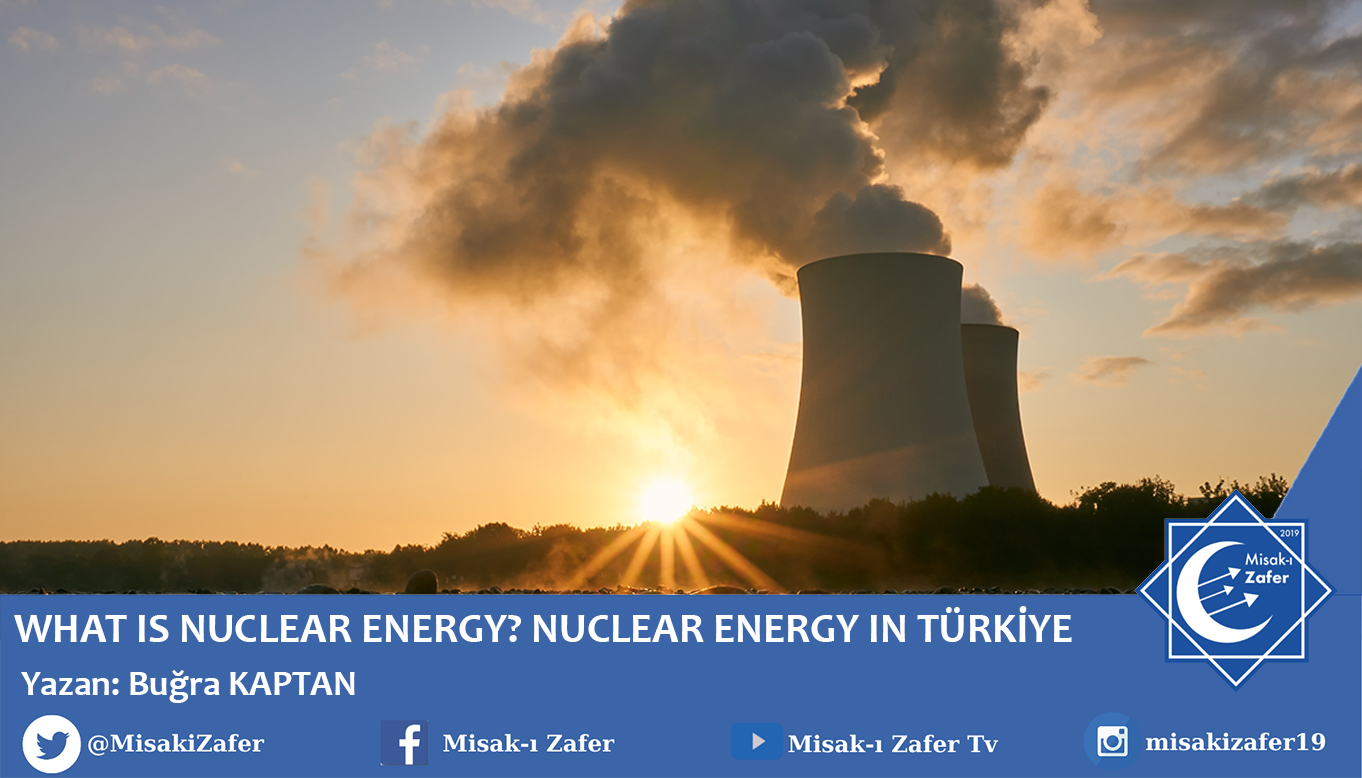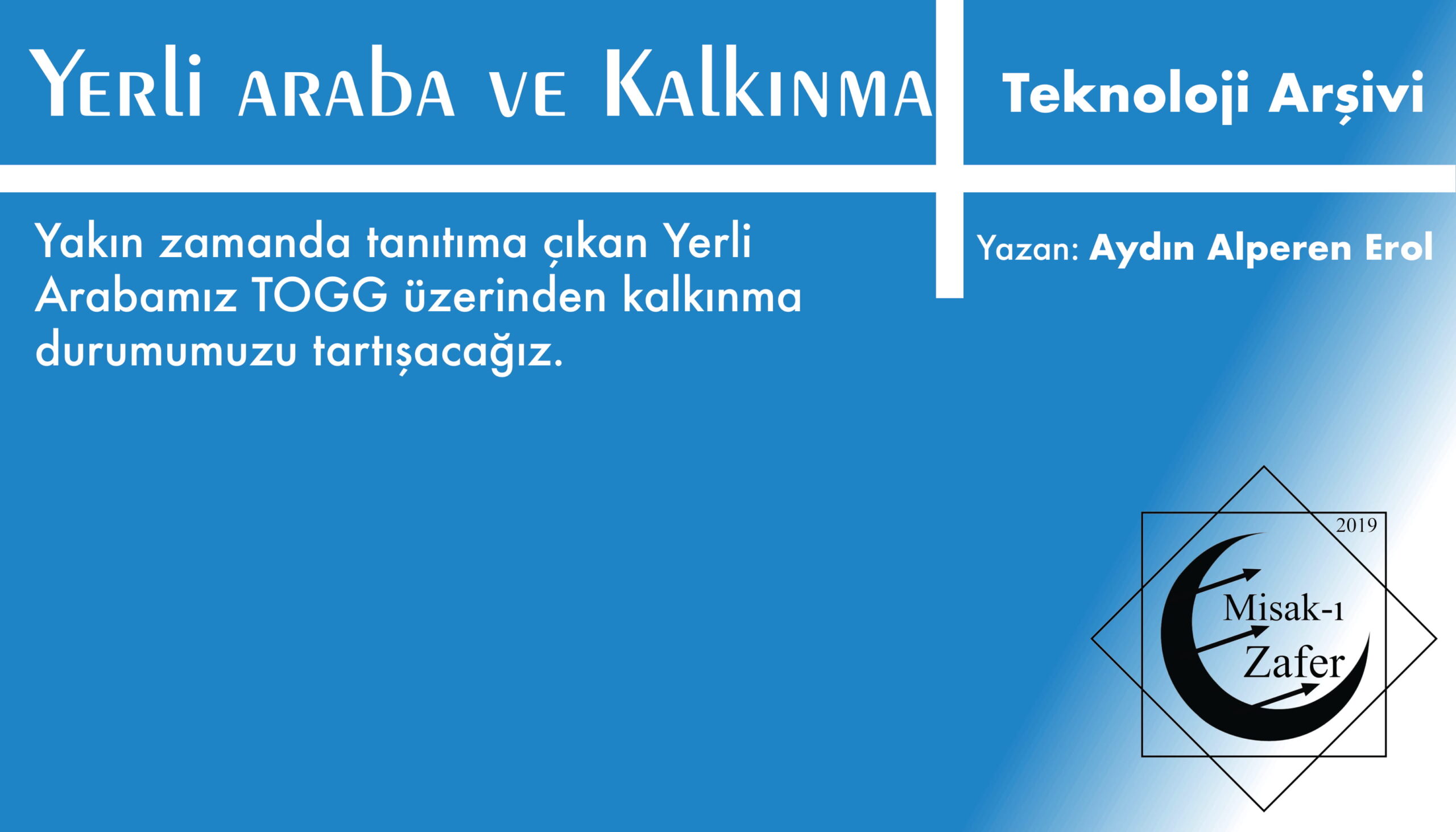
Kernel(nucleus) which is in the center of atoms determined the properties of substances found in nature. The nucleus made up of particles called a neutron and a proton. It can be compared to an energy packet. Nature, tries to build this energy packet using the least energy. Initially some atomic nuclei formed with too much energy may lose this excess energy over time and emit radiation or particles. These nuclei are called radioactive nuclei. The energy released during the fission or fusion of atomic nuclei is called nuclear energy. Today Fission reactions are commonly used in nuclear power plants. In these Fusion reactors, the nucleus of a Uranium-235 split by a neutron produces an energy and this energy turns into electrical energy. During nuclear power generation, The nuclei of some atoms, such as uranium or plutonium, are bombarded with neutrons and explode, it breaks apart, producing countless particles with masses much smaller than these nuclei. Newly emerged neutrons are crashes into another U-235 nuclei and causing them to split too. This reaction is called a “chain reaction”. The difference between the masses of the particles before and after the explosion, is the amount of matter that is converted into heat energy that is lost during the splitting of atomic nuclei. This revealed energy is called “nuclear energy”. If this event occurs in many nuclei simultaneously, a nuclear bomb is obtained and to make this energy usable, the reaction is slowed down in nuclear reactors. Thus, electrical energy is produced by heating a liquid with this nuclear energy.
Nuclear power plants in the world provides 20% of the electricity used in the world, provides 7% of the energy used in the world. They produce electricity at prices close to fossil fuels. Nuclear reactors have zero smoke and CO2 emissions. There are 440 nuclear power plants in 31 countries, 30 of which are under construction.In total, they produce 351 billion watts of electricity. There are several types of nuclear reactors. Pressurised water reactor (PWR) is the most common type with about 300 operable reactors for power generation. PWRs use ordinary water as both coolant and moderator. The design is distinguished by having a primary cooling circuit which flows through the core of the reactor under very high pressure, and a secondary circuit in which steam is generated to drive the turbine. Another one Boiling water reactor (BWR) is type of reactor has many similarities to the PWR, except that there is only a single circuit in which the water is at lower pressure (about 75 times atmospheric pressure) so that it boils in the core at about 285°C. The reactor is designed to operate with 12-15% of the water in the top part of the core as steam, and hence with less moderating effect and thus efficiency there. This two is the most common type of nuclear reactor. There is some another reactor types like Advanced gas-cooled reactor (AGR), Light water graphite-moderated reactor (LWGR) and Fast neutron reactor (FNR). Pressurized water reactor (PWR) is used in countries such as USA, France, Japan, Russia, China, South Korea. Boiling water reactor (BWR) is used in countries such as USA, Japan, Sweden. Advanced gas-cooled reactor (AGR) is the only type of reactor in the UK. Fast neutron reactor (FBR) is only used in Russia.
Radioactive Wastes and Their Effects on the Environment is a different issue that needs to be examined. The most important advantage of nuclear fuels is It does not emit sulfur and nitrogen oxides substances into the environment. Its also does not emit the products such as CO2 that cause global warming. However, nuclear fuels also have a unique environmental impact. Radioactive wastes cause the most difficult environmental problems. Radioactive wastes are divided into two main classes. First one is low-impact wastes which is like gloves, protective suits using with nuclear materials and solutions using on laboratory. Radioactive elements in this class have short half-lives and their efficiency is low. These are placed in concrete blocks and placed in the ground.They can be buried and become radioactive properties are lost 300 years later. The main problem is get rid of the environmental effects fuel rods used in nuclear reactors and other high efficiency of waste. Fuel rods, substantial amounts of uranium and they contain a large number of radioactive elements formed from the breakdown of plutonium. With a half-life of 24000 years, plutonium is very harmful and can cover a large area in any nuclear accident and cause long-term contamination. In countries with a large number of nuclear reactors, especially in the United States, there is a large amount of radioactive waste is temporarily stored under water and awaits to be taken to the place where it will be stored forever. Appropriate storage sites must be geologically stable for thousands or tens of thousands of years. There are great debates today for the selection of such places. As can be seen, “clean” nuclear energy does not have environmental problems such as acid rain and global warming. However, it also brings its own unique problems. There have been two very bad accidents at nuclear power plants. The first of these occurred at the nuclear power station called Middleton “Three Mile Island” (TMl) near Pennsylvania in 1979. TMI reactor is a light water type reactor where it is used water as a moderator and coolant. Some coolants were lost in the accident. However, the fission particles caused the fuel rods to overheat and continued to degrade. Partial melting has occurred and one of the reactors cracked. The crack caused the release of radioactive vapor into the atmosphere and Reactor shut down. The second accident happened in Chernobyl in Ukraine in 1986. Graphite was used as a moderator in this reactor. When the cooler is accidentally turned off the chain reactions got out of control. The temperature has risen tremendously and caused melting and during melting, the graphite coolant surrounding the reactor rods burned. radioactive fumes spilled out of the reactor. Radioactive materials spread to many parts of Europe, Canada and America. Although very few people lost their lives in the explosion, thousands of people died for years due to the radiation emitted after the explosion. Other nations still use nuclear power without accident. In France and Japan, two-thirds of electrical energy obtained from nuclear power plants. The safety of nuclear reactors appears to be quite high on record, but nuclear waste is quite poses a significant problem.
Nuclear energy studies in the world, with different initiatives in different countries, started simultaneously. Before and during the second world war, the use of nuclear energy for the purpose of making weapons was the priority of the warring states. Therefore, there was no sharing of information, data or technology between countries. There are three dimensions of cooperation between countries when it comes to the use of nuclear energy. These are the peaceful use of nuclear materials, trade relations and technology sharing. The increasing need for electrical energy on a global scale has made the establishment of nuclear power plants interesting for both developed and developing countries. As a result, initiatives in nuclear power plant construction and related technologies have increased, which has led to an increase in the efforts of countries with nuclear technology to build nuclear power plants in other countries. Agreement with Russia, and the negotiations with South Korea, Japan and France are example of these studies.
1st Geneva Conference held in Geneva in 1955 was about “The peaceful use of atomic energy” After this Studies in the field of nuclear energy have started in Turkey. Turkey was the first country to sign the “Cooperation Agreement on the Use of Nuclear Energy for Peaceful Purposes” dated 5 May 1955 with the USA. Turkey has started initiatives in order to establish the technical infrastructure, establish a research reactor and train manpower to work. The Prime Ministry Atomic Energy Commission (AEK) was established in 1956 as a specialized agency to carry out nuclear activities. Although attempts to establish nuclear power plants have a history of approximately 60 years in Turkey, the legal framework was established with the 2007 “Establishment and Operation of Nuclear Power Plants” and “Nuclear Energy Law”.An intergovernmental agreement was signed between Turkey and Russia in May 2010 for the establishment of a nuclear power plant in Akkuyu. Akkuyu Nuclear Power Plant is Turkey’s first nuclear power plant under construction. There are a total of four pressurized water reactors (PWRs) in Akkuyu. Although the reactors at Kalininskaya Nuclear Power Plant are taken as reference in their production, the third generation of these, which will be produced for the first time, will be used in Akkuyu. As a matter of fact, each of the three reactors in Kalininskaya will be 1000 MWe, while each of the reactors in Akkuyu will be 1200 MWe. The first unit of the power plant, which will consist of four units, will be operational in 2023. As the second project, it was decided to start the construction of the power plant in 2017, with the interstate agreement signed with the Government of Japan on May 3, 2013 for the “Sinop Nuclear Power Plant Project”.In the consortium that will operate the power plant, it has been discussed on behalf of Turkey that the EÜAŞ will have 49%, the Japanese company will have 30%, and the French company will have 21%.
A different situation regarding the establishment of nuclear power plants in Turkey is the threat of terrorism.The Republic of Turkey has entered into the process of combating many different terrorist organizations, especially since the 1980s. At the head of these terrorist organizations, there is an organization known as the PKK. This terrorist organization, which is active especially in the eastern and southeastern regions of Turkey, is recognized as a terrorist organization by many international organizations, especially the European Union, the United Nations and NATO, and many states. Since its establishment, this organization has caused the death of many innocent people, the martyrdom of soldiers and police, the damage to many state institutions, and the destruction of many national values. This organization has also damaged national investments that were previously valuable to Turkey. The destruction of electricity lines in Hakkari and the destruction of natural gas pipes comes from Iran can be given as examples. Nuclear power plants are important besides being an energy source It is dangerous enough to cause irreparable consequences in the event of an accident or explosion. Therefore, it is extremely important that the nuclear power plants to be established are well protected. It is also important that the location of nuclear power plants be away from the crowd in case of a possible threat.
As it has been said and experienced for years, Turkey is a country where energy demand is increasing and it is a country that urgently needs expansion in energy production. In order to meet the energy demand, it is essential to create an alternative to our domestic resources, which are predicted to be completely depleted. Almost all of the natural gas, which meets more than half of the electricity production, is imported from outside the Turkey. Our dams built in our country have flooded our acres of land, moreover, they are insufficient. It is necessary to go to energy diversity and reduce foreign dependency. In terms of energy needs, it is clear that nuclear energy is an important alternative in Turkey. In addition to these, it is important that Nuclear power plants create a large employment for engineers and scientists. As it is known, physicists and physics engineers in Turkey have great problems in terms of employment. A nuclear power plant to be established in Turkey will not only fullfil Turkey’s energy needs, but will also be important for employment and economic growth. The growing concerns over greenhouse gas emissions, the recent volatility associated with oil and gas prices, the uncertainty surrounding the political stability of oil producing countries, and the dependency on foreign energy sources have revitalized interest in the role of nuclear energy as a viable energy source. Although security and environmental issues are the main concerns, nuclear energy is important for Turkey’s development. Nuclear power plants will be beneficial for scientists in terms of employment, reduction of foreign dependency in energy, and international cooperation based on technology. In order to achieve these gains, the location selection of the reactor, precautions against terrorist threat, and measures against occupational accidents are of primary priority. When necessary precautions and precautions are taken, nuclear power plants are profitable and a good investment in the long run.
BIBLIOGRAPHY
– TMMOB FİZİK MÜHENDİSLERİ ODASI NÜKLEER ENERJİ RAPORU 2011
– ERGÜN,Suzan, ATAY POLAT,Melike, NÜKLEER ENERJİ VE TÜRKİYE’YE YANSIMALARI, İnönü Üniversitesi Uluslararası Sosyal Bilimler Dergisi, İdari Bilimler, ISSN: 2147-0936 Vol. 1, No. 2, 2012, 34-58.
-GÜRBÜZ,Özgür, ELEKTRİK ENERJİSİ ÜRETİMİNDE RÜZGÂR İLE NÜKLEER ENERJİ KAYNAKLARININ MALİYET YÖNÜNDEN KARŞILAŞTIRILMASI, T.C. MARMARA ÜNİVERSİTESİ SOSYAL BİLİMLER ENSTİTÜSÜ İŞLETME ANABİLİM DALI ÜRETİM YÖNETİMİ VE PAZARLAMA BİLİM DALI, Yüksek Lisans Tezi, İstanbul, 2010
-AKYÜZ,Emrah, TÜRKİYE’NİN NÜKLEER ENERJİ POLİTİKASI VE TERÖR TEHDİDİ, International Journal of Social Science, The University of Leeds, Leeds, 2015
-KADERLİ,Damla, TÜRKİYE’NİN NÜKLEER ENERJİYE VE NÜKLEER SİLAHLANMAYA BAKIŞI, Uludağ Journal of Economy and Society / B.U.Ü. İktisadi ve İdari Bilimler Fakültesi Dergisi, Cilt 35, Sayı 2, Bursa,2016
-WORLD NUCLEAR ASSOCIATION WEB SITE,NUCLEAR POWER REACTORS, Information Lab, 2022
-APERGIS,Nicholas, PAYNE,E.James, A PANEL STUDY OF NUCLEAR ENERGY CONSUMPTION AND ECONOMIC GROWTH, College of Arts and Sciences, Illinois State University, Normal, IL 61790-4100, United States, ELSEVIER ECONOMICS JOURNAL, Illinois,2009
– WHICKER, F. Ward, SHULTZ,Vincent, Radioecology: Nuclear Energy and the Environment, Vol.1
International Standard Book Number 0-8493-5353-X (Volume 1)
– RAYMOND,L.Murray, KEITH,E.Holbert, NUCLEAR ENERGY, AN INTRODUCTION TO THE CONCEPTS, SYSTEMS AND APPLICATIONS OF NUCLEAR PROCESS, 7.Edition,
International Standard Book Number 978-0-12-416654-7
-SAÇMACI,Şerife, ATMOSFERİK KİRLENME DERS NOTLARI, ERCİYES ÜNİVERSİTESİ FEN FAKÜLTESİ KİMYA ANABİLİM DALI, KAYSERİ,2022
Buğra Kaptan
Latest posts by Buğra Kaptan (see all)
- WHAT IS NUCLEAR ENERGY? NUCLEAR ENERGY IN TÜRKİYE - 15 Ekim 2022
- MARTIN LUTHER KING VE KISACA REFORM HAREKETLERİ - 20 Eylül 2022
- UNFORGETTABLE GRIEF ‘’KHOJALY’’ - 25 Şubat 2022
- TARİHİN KANLI YÜZÜ: AHISKA SÜRGÜNÜ - 8 Şubat 2022
- BATI TRAKYA TÜRKLERİNİN KISA TARİHİ - 12 Ocak 2022
 TÜRK VE TÜRKİYE HUSUMETİ OLANLARA
TÜRK VE TÜRKİYE HUSUMETİ OLANLARA  KAYSERİ’DE VE SURİYE’DE YAŞANAN OLAYLAR HAKKINDA
KAYSERİ’DE VE SURİYE’DE YAŞANAN OLAYLAR HAKKINDA  KADİM TÜRKLERDE KURBAN RİTÜELİ
KADİM TÜRKLERDE KURBAN RİTÜELİ  YÜCE TÜRKLERDE DAĞ KÜLTÜ
YÜCE TÜRKLERDE DAĞ KÜLTÜ  Yabancılar Hukuku Kapsamında Önemli Kavramların Değerlendirilmesi
Yabancılar Hukuku Kapsamında Önemli Kavramların Değerlendirilmesi  TÜRK DİASPORASININ YURT DIŞINDAKİ ÇALIŞMALARI
TÜRK DİASPORASININ YURT DIŞINDAKİ ÇALIŞMALARI  MİLİTER İDMAN KULÜBÜ: TÜRK GÜCÜ
MİLİTER İDMAN KULÜBÜ: TÜRK GÜCÜ 
